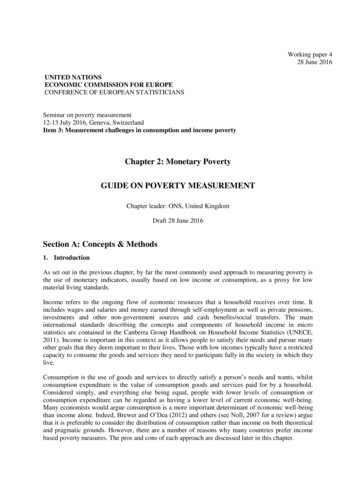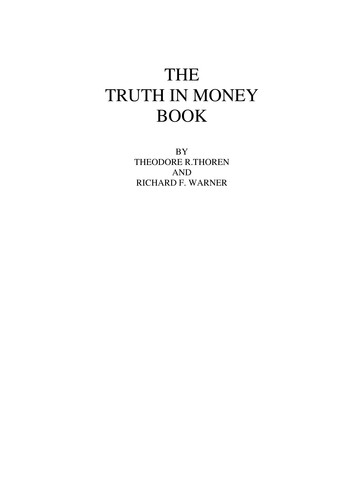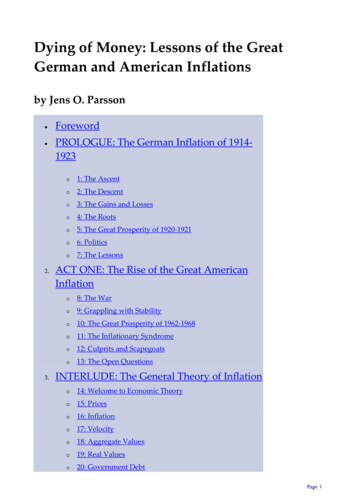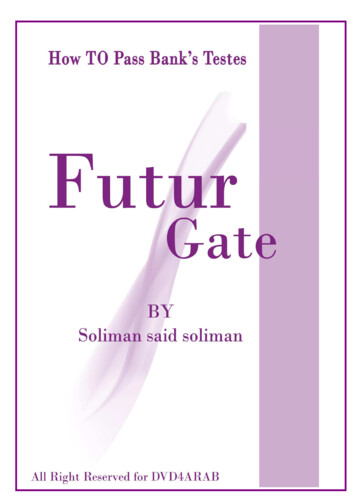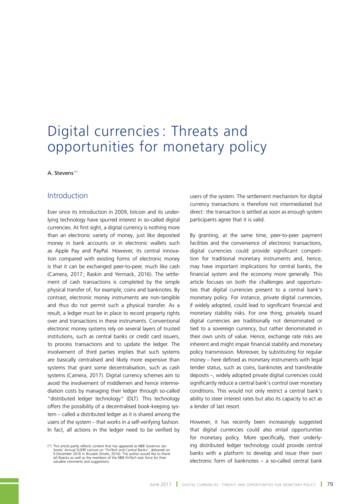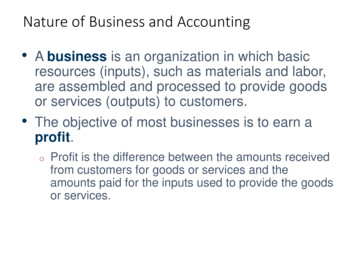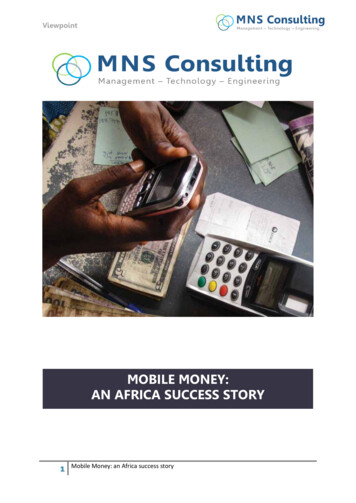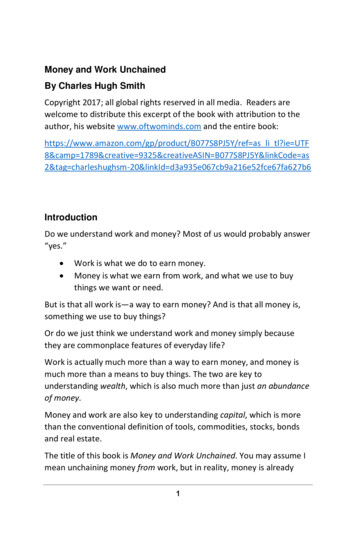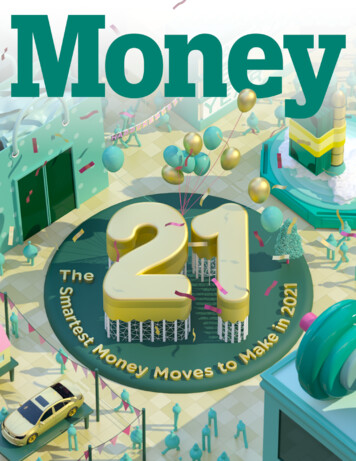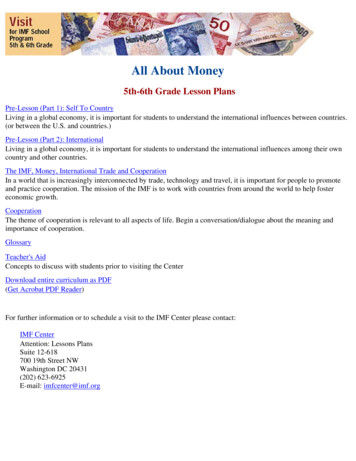
Transcription
All About Money5th-6th Grade Lesson PlansPre-Lesson (Part 1): Self To CountryLiving in a global economy, it is important for students to understand the international influences between countries.(or between the U.S. and countries.)Pre-Lesson (Part 2): InternationalLiving in a global economy, it is important for students to understand the international influences among their owncountry and other countries.The IMF, Money, International Trade and CooperationIn a world that is increasingly interconnected by trade, technology and travel, it is important for people to promoteand practice cooperation. The mission of the IMF is to work with countries from around the world to help fostereconomic growth.CooperationThe theme of cooperation is relevant to all aspects of life. Begin a conversation/dialogue about the meaning andimportance of cooperation.GlossaryTeacher's AidConcepts to discuss with students prior to visiting the CenterDownload entire curriculum as PDF(Get Acrobat PDF Reader)For further information or to schedule a visit to the IMF Center please contact:IMF CenterAttention: Lessons PlansSuite 12-618700 19th Street NWWashington DC 20431(202) 623-6925E-mail: imfcenter@imf.org
Pre-Lesson (Part 1): Self To Country(Activity: Five Rings)Theme: InternationalObjectives:1. Enable students to work together and individually to explore geography on a local and international level.2. Students will demonstrate object-based learning and make connections between objects and geography.Rationale: Living in a global economy, it is important for students to understand the international influencesbetween countries. (or between the U.S. and countries.)LESSON PLANThe Five Rings ActivityDivide the class into four groups. Assign each group one of the following rings:1. self2. family3. your home town4. country (the fifth ring is the world and is discussed later)To help the class appreciate the activity and the relationship of the five groups, display the poster of the Five Rings.Directions for brainstorming: each group is responsible for identifying three to six ideas that will explain your ring.Encourage students to think of both personal and universal objects.Helpful questions to pose to each group: SelfA. An object from your roomB. An object that represents your favorite hobbyC. An object that you have made FamilyA. An object from your homeB. A photograph of your familyC. Memorabilia from a family activity/trip Your Home TownA. Is there a popular sports team from your hometown?What object would you choose to represent this sport?B. Is there a special food from your hometown?
C. Is there a trademark or an outdoor sculpture in your hometown? CountryA. What piece of cloth is identified as from your country?B. What do we use to pay for goods?C. Can you think of an object in a museum or around the country that is special to your country?Allow 5 - 10 minutes for group work and ask each group to report their lists of objects to the class.Recommended homework assignment: In preparation for the second pre-lesson, ask each student to bring to class asmall object from their home that was made in another country.
Pre-Lesson (Part 2): International(Activity: Fifth Ring)Theme: InternationalObjectives:1. Enable students to work together and individually to explore geography on a local and international level.2. Students will demonstrate object-based learning and make connections between objects and geography.Rationale: Living in a global economy, it is important for students to understand the international influences amongtheir own country and other countries.LESSON PLAN:Recap of Pre-Lesson (part 1):Where did all the objects that we discussed yesterday come from? These objects were either made in the UnitedStates or in other countries. But also think about the raw materials to make the objects. For example, someone mighthave selected a photograph to define his or her family. Where was the camera made that took the picture? Wherewere the film, pho-tography paper and development chemicals made? Japan is known for making and export-ingcameras — possibly many of these objects were made in Japan.Let's now look at the fifth ring — the world. Your homework assignment was to bring to class an object from anothercountry. Everyone will have an opportunity to share his or her object with the class and to point on the world mapwhere the object is from. By sharing our objects from other countries, we will see how international and integratedour world is. (This exercise can also be illustrated by having all the students look at the labels in their clothing.)When we do the International Monetary Fund activities, we will explore how goods are traded from one country toanother and learn about the role of the IMF in international trade and cooperation.
The IMF, Money,International Trade and Cooperation(Activities: Cornerstones of the IMF and Trading Around the World)Themes: Trade, Cooperation, Money and the International Monetary FundObjectives:1. Students will enhance their comprehension of international trade and the role of the IMF.2. Students will raise their awareness about the benefits of cooperation.3. Students will be able to participate in a collaborative learning environment where the students teach and learnfrom each other.Rationale: In a world that is increasingly interconnected by trade, technology and travel, it is important for people topromote and practice cooperation. The mission of the IMF is to work with countries from around the world to helpfoster economic growth.LESSON PLAN:1. ADVANCED ORGANIZERA. Visit lobby with flags - emphasize theinternational nature of the Fund.B. Brief introduction to the purpose of the IMF.C. Revisit students' understanding of "international" from pre-lesson:A. Can you recap the Five Ring activity?.B. What kinds of objects did you bring from home?C. the IMF has designed two fun activities for you today. One is called the "Cornerstones of theIMF" four ways to understand what the IMF is all about. The second activity is called "TradingAround the World" where you will get an opportunity to buy and sell goods from all over theworld.2. CORNERSTONES OF THE IMF (40 minutes)Divide the class into 4 groups and assign a teacher to each group. Each group will get 20 minutes to worktogether to "solve" the activity. Afterwards, each group will present their findings to the class as a whole (eachgroup will have 5 minutes). Group #1: Past and Present Forms of Money Group #2: Development of Money Group #3: The IMF Group #4: Membership Benefits
3. TRADING AROUND THE WORLD (20 minutes)Divide the class into 5 teams (each group will represent a continent as well as 2 products). The objective of thegame is to buy and sell as many products as possible, using the least amount of currency. Each team will beginwith an equivalent amount of currencies and are responsible for setting prices to selling and buying goods.After 10 minutes of trading, each group will explain their strategy in selling and buying the products. Firstreport: what products did they export, what products did they import, how will they use the new imports, andhow much profit or loss did the team make.CONTINENTEXPORTCURRENCYPrintable RicePrintable Asian currencyPrintable AsiaPrintable SilkPrintable TractorsPrintable WheatPrintable European currencyPrintable EuropePrintable Cocoa BeansPrintable African currencyPrintable PeanutsPrintable Africa
Printable TrucksPrintable CottonPrintable North American currencyPrintable North AmericaPrintable BananasPrintable LumberPrintable South American currencyPrintable South AmericaPrintable WoolPrintable AustraliaPrintable MetalsPrintable Australian currency4. SUMMARIZERCooperationA. Emphasize how the group activities during "today's visit" are dependent on cooperation from classmates.Just as you have demonstrated cooperation during today's "visit" to IMF, the IMF practices cooperationas well. Here are three ways the IMF shows cooperation:1. Countries talk to each other and work together (no country should take economic measures thatwill hurt the economic well being of another country). Board of Directors (1 Managing Director, 3Deputy Managing Directors, and 24 Executive Directors) meet 3 times a week to discusseconomic issues affecting individual countries and their votes are cooperative with a majority rule(show picture of IMF Board Room). Most decisions are discussed until they reach a commonagreement "consensus" and don't come to a vote.2. A small, multi-national team of economists visits each member country once a year to makesuggestions of how to keep that economy healthy.
3. IMF helps countries in economic need to develop their country's economic pro-gram. If theeconomy of a country suffers an economic problem, the country goes to the IMF to ask for help.The result of this cooperation is a program in which a country tells the IMF how they are going tocut their spending and strengthen their economy.In addition to learning about cooperation, what else did you learn today about the IMF?A. The IMF is an international organization.B. The IMF helps to stabilize currencies, which helps to stabilize economies, which ultimately leadsto improved living standards of people around the world.
Group #1:Past and Present Forms of MoneyOpen the Red Treasure Chest of Currencies: everyone picks one to two forms of money. Let’s see what we can learnfrom these money forms by using a visual framework about:SHAPE, SIZE, COLOR, MATERIAL, FUNCTIONThis framework can be applied to looking at any object whether it is a coin, toy, clothing, jewelry, etc. Everyonedescribes the shape, size, color, material and function of their money form(s). Then as a group, discuss how theseobjects are similar and how they are different.To learn more about your particular money form(s), answer the following threequestions:1. what country/continent were these money form(s) from?2. what time period were these money form(s) used?3. what else is interesting about these money form(s)?Treasure Chest of Currencies includes:The AmericasCattleShell BeadWampumCacao BeansSilver "Miracles"Printable CattlePrintable Cacao BeansAfricaPrintable Shell Bead WampumPrintable Silver "Miracles"Printable Salt MoneyPrintable Cowrie Shell MoneySalt MoneyCowrie ShellMoneyAggry Bead BraceletCattle
Printable CattlePrintable Aggry Bead BraceletEuropeBead NecklacePrintable Bead NecklaceSoutheast AsiaGlass BeadsPrintable Printable Glass BeadsChina and Japan Cowrie ShellMoneyChinese CoinsPrintable Cowrie Shell MoneyGloballyPrintable Chinese CoinsCoins and paper currencyPrintable Coins and paper currencySO WHAT? Group of students are to lead a discussion with the entire class using the following four questions:1. What are the most common forms of money used today? (coins, paper currency, credit cards, checks, travelerschecks)2. How are ancient money forms different from money today? (Encourage the group to "show and tell" theirmoney form(s) with the entire class.)3. What are the advantages and conveniences of money forms today?4. Can you think of any problems or disadvantages to today’s money?
Group #2:Development of MoneyStudents will study both the "Money Wheel" and label text to understand money terms.Money Wheel (shaped as coins with central arrow) includes 4 sections:1. What is money?measure of value and medium of exchangeA. "money is anything that people will routinely accept aspayment in exchange for goods and services."to money2. How did barter develop? (using livestock and crops)Illustrate barter with playground transaction, i.e. "I'll trade mypretzels for your chocolate chip cookies."3. Development of money using precious metalscoinspapermoney4. Circulation of moneyneed for convertible currenciesAct out the following 2 scenes that address the following concepts:Printable Money WheelHardships of Earlier forms of "Money:"1. How do we determine the worth of bartered goods?2. Were the precious metals and coins convenient for travel?3. Without convertibility (explain convertibility) how can people spend their country's money inanother country?Conveniences of Modern Money:(include modified version of Treasure Chest of Currencies)1. How is money more efficient than barter?2. Why is paper money more convenient than coins and precious metals?3. What are the advantages of being able to convert money from country to country?SO WHAT? It was the history of money that helped us to develop the current conveniences of moneytoday. How do you think money will become even more convenient in the future? How money can beadapted for electronic transactions? What will money look like?
Group #3:The IMFCreate an architectural image that represents the IMF and convert to a magnetic puzzle. Students will overlay the answers ontothe puzzle in response to the following question: "What are five important elements of the IMF?" Let's place them in a houseto better visualize the IMF.5 important elements: what are they?1. When was the IMF founded? And where?2. What are the "rules" of the IMF called?3. How many staff/people work in the IMF today?4. How many Executive Directors, Managing Directors and Deputy Managing Directors are there?5. How many countries belong to the IMF membership?Students can put the puzzle together as the IMF staff member speaks.Printable IMF House Puzzle front pagePrintable IMF House Puzzle back pageAnswers are:1. Founded in 1944 at Bretton Woods, NH2. Articles of Agreement3. 2700 staff members from 184 member countries4. 1 Managing Director/3 Deputy Managing Directors/24 Executive Directors5. 184 member countries represented by their Governors (Finance Ministers, Central Bankers)IMF staff (or teacher if doing the exercise in a classroom setting) to explain the "flow" of how the IMF in organized. The roofis the 184 member countries represented by the Miniseries of Finance (or Central Bankers) in their own home capitals aroundthe world. They then delegate everyday work to the 24 Executive Directors (show picture of Board Room). The ExecutiveDirectors then delegate the work of the Fund to the staff (2,700 staff on the "ground floor" of the house.)Encourage deductive thinking: "What are the differences between the beginning of the IMF and the IMF today?1. How old is the IMF today? (58 years)2. What is one of the major activities of the Fund? (economic analysis-explain to students)3. What is another major activity of the Fund? (technical assistance-explain to students)4. What is a third major activity of the Fund? (lending to member countries that need financial assistance-explain tostudents)5. How many more member countries are there today compared to 1945? (184-44 140?)SO WHAT? The "so what" of this exercise is to show that the IMF is the international guardian of economic stability; helpscountries keep their economies on an even track; and that it is in partnership with all the member countries to make life betterfor all the member countries.
Group #4:Membership Benefits and ObligationsNewland is a new country and wants to join the IMF. As a class, you will need to figure out two things: what are theobligations of Newland's new membership and what are the bene-fits Newland will enjoy as a member of theinternational financial community? Divide the class into two groups – GROUP A and GROUP B. Group A isresponsible for researching the obligations of membership and reporting their findings to the class. Group B isresponsible for researching the benefits of membership and reporting their findings to the class.GROUP A: Obligations of Membership (IMF gold medallion)As representatives of Newland, what will your country have to do to be a member of theIMF? Members are required to share information (cooperate) on economic data (bankingand government spending, taxes and exchange rate policies) with other countries.The four main obligations are as follows:1. Agree to the code of conduct in the IMF Articles of AgreementA. define "code of conduct"B. define the IMF Articles of Agreement – "An international treaty that sets outthe purposes, principles, and financial structure of the IMF." The Articles,which were entered into force in December 1945, were drafted byrepresentatives of 45 nations at a conference held in Bretton Woods, NewHampshire.Printable Obligations of theIMF Membership2. Pay a quotaA. quota is like a membership subscription – "The amount that each membermust pay to the IMF on joining."3. Should allow the exchange of it's currency (money) for foreign currencyA. Creates best conditions for good (efficient) international trade4. Strive for openness in economic policies affecting other countries.A. Helping countries develop strong economies that can make the most of an"open" world economy (this means encouraging the free flow of imports andexports i.e. international trade.)GROUP B: Benefits of Membership (IMF gold medallion)There are currently 184 countries that have voluntarily joined the IMF (almost everycountry in the world). The benefits are five-fold:1. access to information on economic policies for all member countriesA. why beneficial? Because your economy is part of a global network ofeconomies, knowing more about these economies helps you run your owneconomy better. Just as if you had a store in a shopping center, knowingabout all other stores, about the rest of the shopping center, helps you tobetter run your own store.2. opportunity to help to decide which are the best economic policies for everyonePrintable Benefits of the IMFMembership
A. why important? All countries are represented in one forum, which is theExecutive Board. These 24 representatives discuss everything openly,convince each other until they reach a consensus.3. access to technical assistance in banking, fiscal affairs, (government spending, taxesand finance) and exchange rate policies.A. why important? The IMF offers training and guidance in the most up to datedevelopments in the fields of banking, fiscal affairs and exchange rates.4. financial support for countries with financial difficultiesA. why important? Suppose you and your family form a club, and eachcontributes some money to it. One of the benefits of your club is that, shouldyou lose your job, or your salary is suddenly reduced because your companyis in bad shape, you can borrow from the pool of money, until you can standon your feet again. Because this pool of money belongs to everyone, the loanwould be given on condition that you do certain things to improve yourability to repay the money you borrowed (conditionality). The same moneycan then be borrowed by another member of the club who may need it. (therevolving character of Fund credit.)5. increased opportunity for trade and investment – This is the result of the 4 previouspointsWHOLE CLASS: Should Newland become a member of the IMF? Why or why not?SO WHAT? Are any of you members of an organization, club, team? Why do you like being a member? Or whywould you like to become a member?
Post-Lesson: Cooperation(Activity: Comic Strip)Theme: CooperationObjective: Students will be able to express their own meaning of cooperation.Rationale: The theme of cooperation is relevant to all aspects of life.LESSON PLAN:Begin a conversation/dialogue about the meaning and importance of cooperation. Draw on examples from the visit toIMF and from the students' personal lives.With paper and pens (supplies in IMF School Program Box), ask students to: Write a four-frame comic strip that represents cooperation.Let students know that the IMF Center has reserved a wall in its website to display their art.
GlossaryMore detailed GlossaryWHAT IS A COUNTRY'S BALANCE OF PAYMENTS?A balance of payments is achieved when the amount of money leaving a country to purchase imports of goods andservices and to invest in other countries equals the amount of money entering the country through the sale of exportsand the inflow of investments. Deficits (shortfalls) or surpluses in the balance of payments can be brought intobalance by increased trade and investment or by moving currency reserves between countries.WHAT IS A COUNTRY'S BALANCE OF TRADE?A balance of trade is the difference between the value of goods imported and the value of goods exported. Afavorable balance of trade implies an excess in the value of exports over imports. An unfavorable balance of tradeimplies the reverse.WHAT IS THE BRETTON WOODS SYSTEM?The Bretton Woods System, conceived at Bretton Woods, New Hampshire in 1944, was implemented by theInternational Monetary Fund until the 1970s. This system provided for fixed exchange rates (based on the U.S. dollarpegged to gold) and aimed for the unrestricted conversion of one currency for another in settling current paymentsbetween member countries. Its purpose was to increase employment, assist trade, and encourage internationalprosperity. The system, abandoned in the 1970s when the U.S. government was no longer able to exchange gold fordollars at 35.00 an ounce, has been replaced by the present regime of surveillance by the IMF over membercountries' exchange policies.WHAT IS CAPITAL?Capital consists of man-made assets, either physical (e.g., machines) or financial (e.g., investments), that are capableof generating income.WHAT IS THE CAPITAL ACCOUNT?The capital account measures all international capital transfers (i.e., long- and short-term loans and grants that privateindividuals and governments make to or receive from foreign private individuals or foreign governments).Capital-account assets represent a country's investments abroad; liabilities the investment of foreigners in thecountry.WHAT IS A CENTRAL BANK?Central banks are institutions responsible for monitoring economic data, overseeing banking, accounting formonetary and gold reserves, and adjusting the money supply in order to keep the economy on course. In the UnitedStates, the Federal Reserve System performs these functions. Their charters usually make central banks independentof government so as to avoid unhelpful political influence.WHAT ARE CENTRALLY PLANNED ECONOMIES?In centrally planned economies, the state, rather than the free market, determines where investments will be made,what will be produced, what the level of wages and salaries will be, and how much products will cost. Centrallyplanned economies are inspired by a socialist, nonmarket philosophy.
WHAT IS CONVERTIBLE CURRENCY?Convertible currency is currency that is accepted in exchange for another currency. A country with externalconvertibility allows nonresidents to exchange its currency for other currencies. A fundamental goal of the IMF isuniversal currency convertibility.WHAT IS CURRENCY?Currency consists of notes and coins used as a medium of exchange.WHAT IS THE CURRENT ACCOUNT?The current account comprises the entries in the balance of payments account that summarize exports and imports ofgoods and services by individuals and governments.WHAT IS DEFICIT FINANCING?Deficit financing occurs when a government spends more money than it can raise by taxation or other means. JohnMaynard Keynes advocated this policy during the Great Depression to increase employment and thereby injectpurchasing power into the sluggish economyWHAT IS DEPRECIATION?Depreciation is the reduction in the value of a currency in terms of other currencies under market conditions becauseof a decline in demand for that currency in relation to its supply.WHAT IS DEVALUATION?Devaluation is the attempt by a government to reduce its currency's value in terms of other currencies. Governmentslower the value of their currency relative to other currencies in order to make their country's products morecompetitive on world markets and boost exports. Devaluation also makes imports less affordable and protects localindustry against foreign competition. During the Great Depression of the 1930s, many countries devalued theircurrencies to help boost their economies at other countries' expense, a practice known as beggaring thy neighbor.Unfortunately, this lowered overall demand for imports and retarded a general recovery. The IMF was foundedpartially in response to this unfortunate practice.WHAT IS A DEVELOPING COUNTRY?Developing countries are partially industrialized countries that usually lack sufficient national income or domesticprivate capital to finance the investment required to reach modern industrial statehood. In the early stages ofdevelopment these countries usually look to multilateral lending institutions for finance. As they become moreeconomically self-sufficient they are able to tap the international capital markets for loans or finance furtherdevelopment.WHAT IS ECONOMICS?Economics is the study of the best way to allocate scarce resources to produce and distribute goods and servicesthroughout society.WHAT IS AN EMBARGO?An embargo legally prohibits some or all trade with a foreign country. Governments resort to embargo to expressdispleasure with the policies of another country and to attempt to coerce the country to change its policies.WHAT IS EXCESS LIQUIDITY?Excess liquidity is the unusual condition of countries' having too much money. (Private individuals seldomexperience this condition). In the late 1970s, the rise in oil prices brought in a flood of money (more than could beimmediately spent) into the oil-producing countries. Prudently, these countries placed much of this excess money inbanks, which soon found themselves in the unusual position of having excess liquidity: more money than they couldconveniently lend.WHAT IS FISCAL POLICY?Fiscal Policy refers to the package of policy initiates used by a government to achieve a satisfactory level of revenuesand expenditures.
WHAT IS A FIXED DOLLAR-GOLD EXHANGE RATE?The dollar-gold exchange rate ( 35.00 one ounce of gold) was established at the Bretton Woods conference in1944. The value of other world currencies was expressed in dollars, and therefore by implication was also pegged togold. Under the Bretton Woods system, any-one could redeem dollars for gold from the U.S. Treasury at the rate of 35.00 per ounce. When inflation began to erode confidence in the value of the dollar, the rush to redeem dollars forgold threatened to wipe out the U. S. gold reserves.WHAT ARE FISCAL OR BUDGET DEFICITS?Fiscal or budget deficits occur when governments expenditures exceed revenues. The way out of a budget deficitmay involve raising taxes, reducing government expenditure, or a combination of both. Obviously none of thesesolutions is popular with the electorate. For this reason, politicians are often loath to make the hard decisionsrequired, the budget deficit worsens, and, in some cases, the government must seek assistance from internationallenders.WHAT ARE FIXED EXCHANGE RATES?Fixed exchange rates are a system in which the exchange value of a currency is kept stable by tying the value of thatcurrency to the value of another currency or basket of currencies (such as five pesos to a dollar). Maintaining a fixedexchange rate requires (a) that a country hold sufficient foreign exchange reserves to intervene in the market toreduce variations in the value of its currency and (b) that it implement fiscal and monetary policies that keep thesevariations small.WHAT ARE FLEXIBLE EXCHANGE RATES?Flexible exchange rates are a system in which the exchange value of a currency is allowed to seek its own level inresponse to market forces. The government issuing the currency engages in little or no market intervention tostabilize the exchange rate.WHAT IS A FREE MARKET SYSTEM?In a free market system, private investors, rather than the state, determine where investments will be made, what willbe produced, what the level of wages and salaries will be, and how much products will cost. The free-market systemis inspired by a capitalist philosophy.WHAT IS FOREIGN INVESTMENT?Foreign investment is the acquisition of assets in one country by government, institutions, or individuals in anothercountry. Foreign investment can be indirect (buying shares of existing enterprises in other countries) or direct (settingup subsidiaries and new enterprises in other countries).WHAT IS THE GDP?The GDP is the gross domestic product: the value of all goods and services produced in a country during one year.The GDP per capita is the gross domestic product divided by the number of people in that country.WHAT IS GLOBALIZATION?Globalization is the integration of the financing, production, and marketing of goods and services across nationalboundaries.WHAT ARE GOLD RESERVES?Gold reserves are the gold bullion stocked by a country's central bank. Under the gold standard, paper currenciescould be exchanged for gold on demand. Although the gold standard has been abandoned, many central banks stillstock gold bullion.WHAT ARE HARD AND SOFT CURRENCIES?Hard currency is a currency widely accepted in foreign trade. Soft currency is a currency whose value is uncertainand which is therefore not widely accepted in foreign trade. When developing countries gained their independencefrom the European colonial powers, they instituted their own official "soft" currencies. With few reserves of hard
currencies, the newly independent countries found it difficult to import goods and services to spur economic growth.WHAT IS AN IMF ADJUSTMENT PROGRAM?An IMF adjustment program is a package of policy measures, agreed on between the IMF and a member country,designed to alleviate the member country's balance of payments problems.WHAT WERE THE IMF'S OIL FACILITIES?The two IMF Oil Facilities were Fund initiatives to channel borrowed money at below-market rates of interest todeveloping countries hardest hit by the rise in oil prices that began in 1973. They were temporary measures;eventually all countries have had to adjust to permanently higher (though fluctuating) oil prices.WHAT IS IMF SURVEILLANCE?IMF Surveillance involves an ongoing examination by the Fund of the economic, monetary, fiscal, and exch
Development of Money Students will study both the "Money Wheel" and label text to understand money terms. Money Wheel (shaped as coins with central arrow) includes 4 sections: Printable Money Wheel What is money? measure of value and medium of exchange "money is anything that people will
